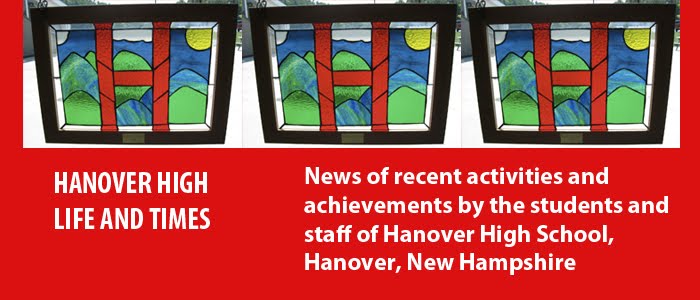


Coach and Chemistry teacher Kevin Lavigne writes: I think this was one of the most difficult contests I have tried to solve with the kids. Fifty teams from all over Vermont signed up this year, but only 20 showed up with machines ready to compete, and only 10 teams had machines that actually worked when the time came. Hanover High began the week before the contest with no machines working, and brought four functioning machines to UVM ... It was a very stressful week with lots of long hours after school. On the day of the contest we had three machines working and one partially working. Three out of the 10 functioning in the whole contest were from Hanover!
This year's design challenge was to build a machine(s) that moved as many apples as possible from the trees in the Orchard to the Market Apple Bin in three five-minute runs. Power for the machine was derived from “wind” blown by no more than two standard window box fans.
The 19 HHS students in five teams placed as follows:
1st and 2nd in the IBM Overall Performance Award
3rd place in the General Dynamics Efficiency award
2nd place in the IEEE Design Profit Score Award
2nd place in the Pizzagalli Performance Bushels Delivered Award
1st place in the NRG Table Award
Click "read more" to see the official description of the contest.
The University of Vermont's College of Engineering and Mathematical Sciences sponsors an annual competition called Design Technology And Society Connection (TASC). The purpose is to give teams of high-school students the challenge and satisfaction of designing, building, and testing a device to perform a specified task. The program begins in September and culminates in December with schools bringing teams (a maximum of five students per team) to UVM to display devices they've created.
This competition is sponsored by businesses in Vermont and surrounding states.
The program is designed to help teachers encourage high school students to use their knowledge of physics and mathematics in a tangible way. The competition features many different aspects that appear in the high school curricula: including physical principles such as, work, energy, efficiency, pressure, friction, and inertia; mathematical principles such as functions, minima, maxima, and logarithms; oral and written communication skills; and drawing skills. Teams who carefully consider all of these aspects of the problem, who look at possible trade-offs in the design, and who thoroughly test the apparatus have the greatest success. Teamwork is a critical factor in determining success.
Tuesday, January 19, 2010
"ONE OF THE MOST DIFFICULT CONTESTS"
Posted by
Hanoverlife
at
7:00 AM
![]()
